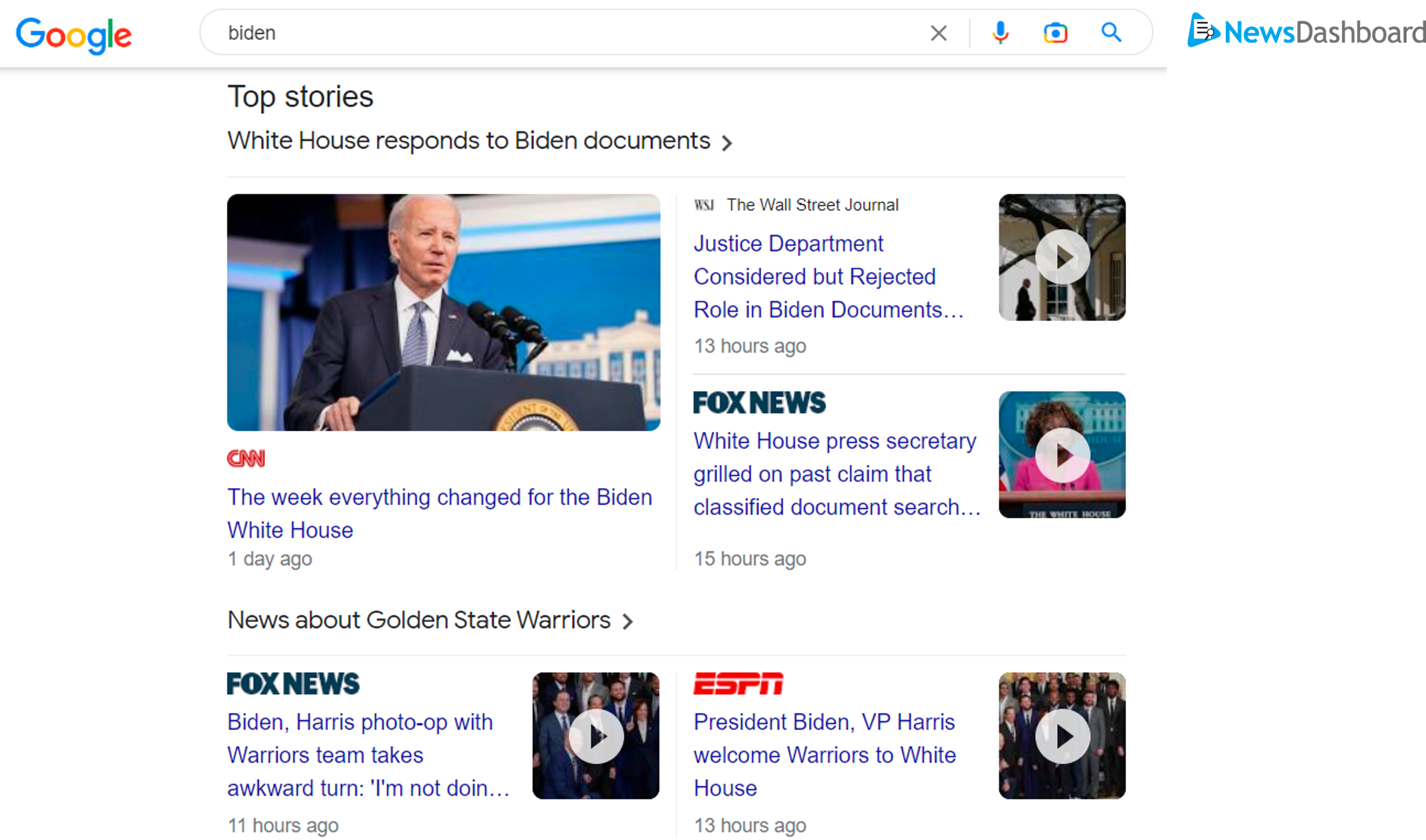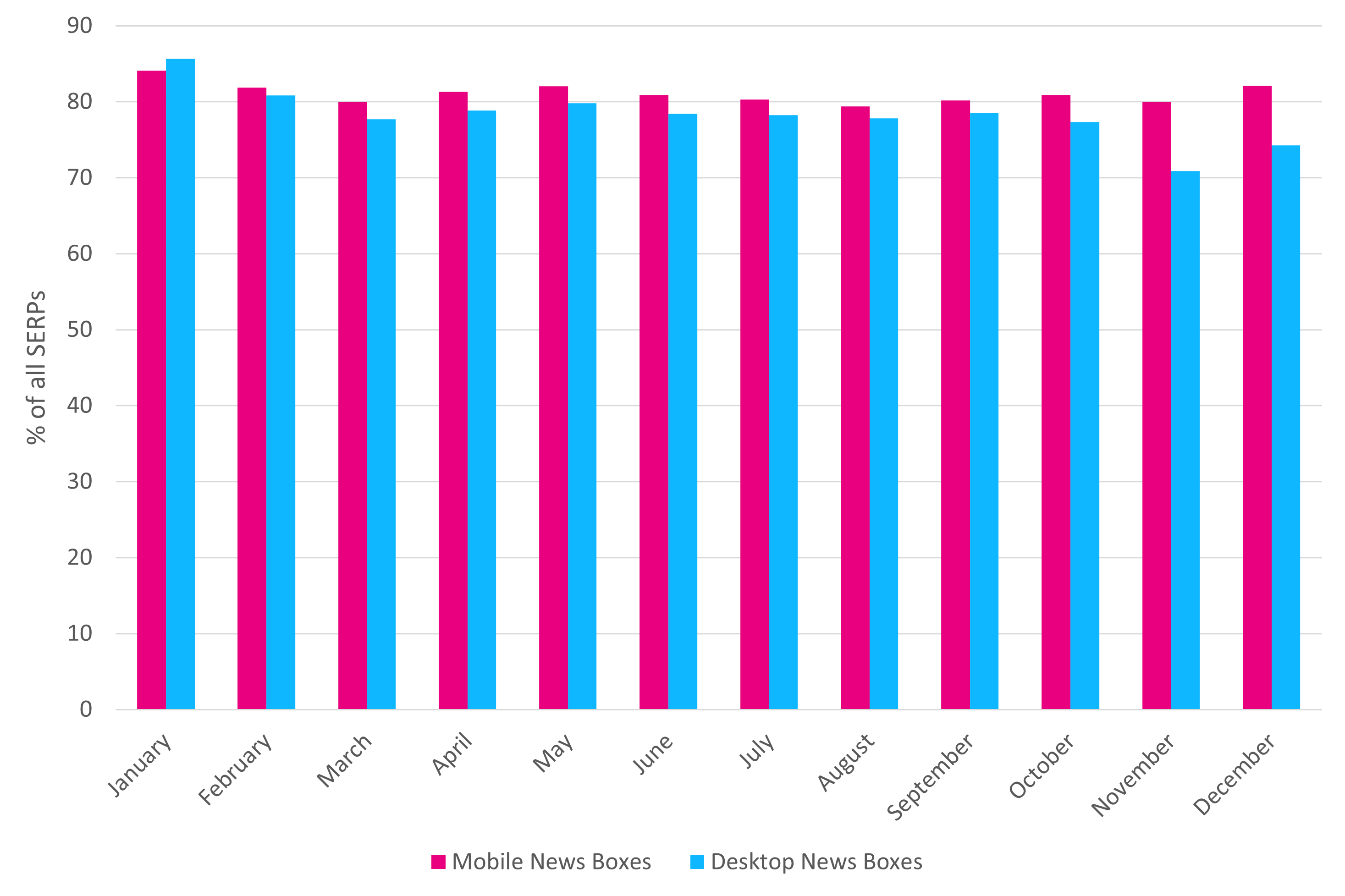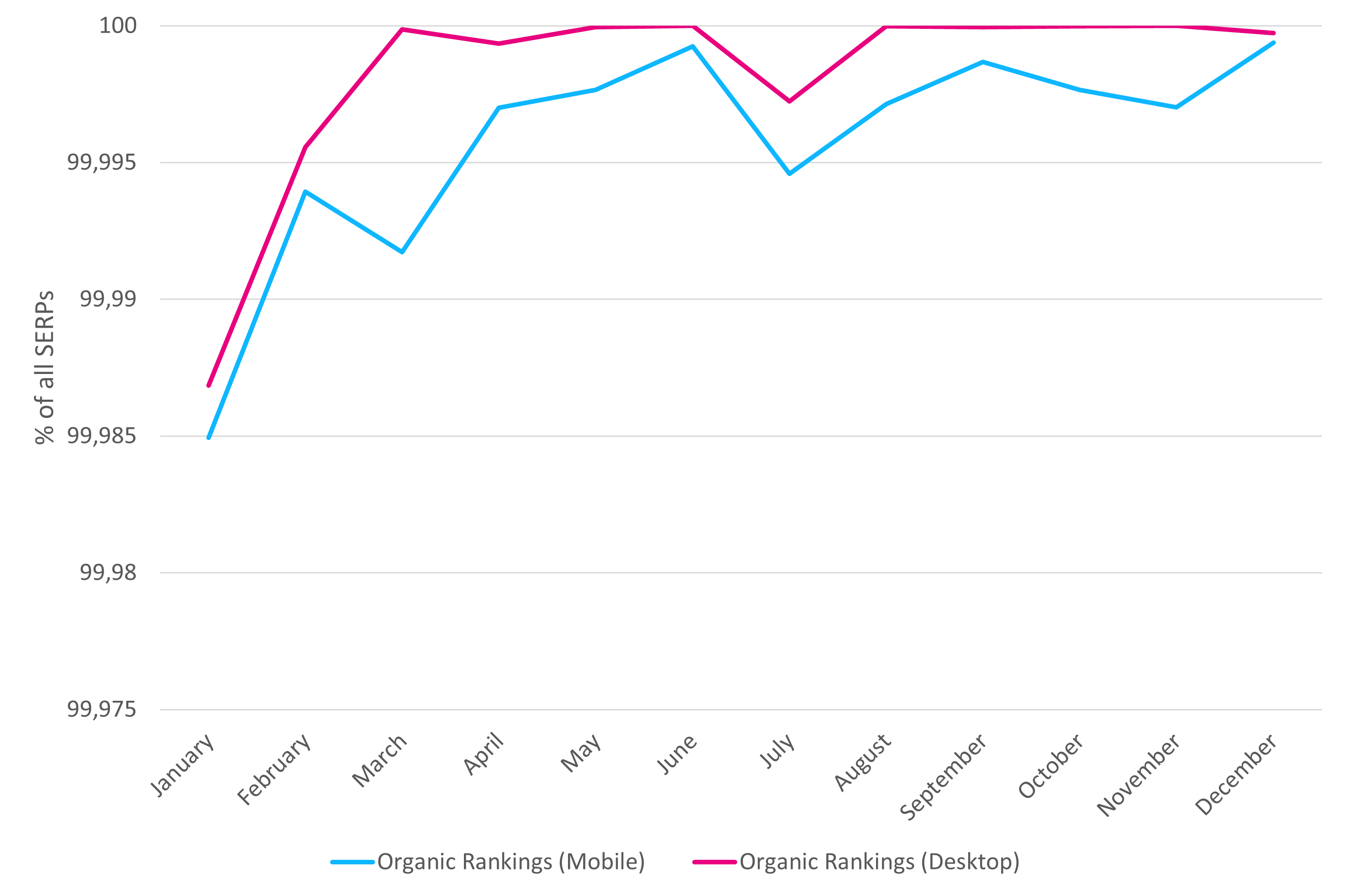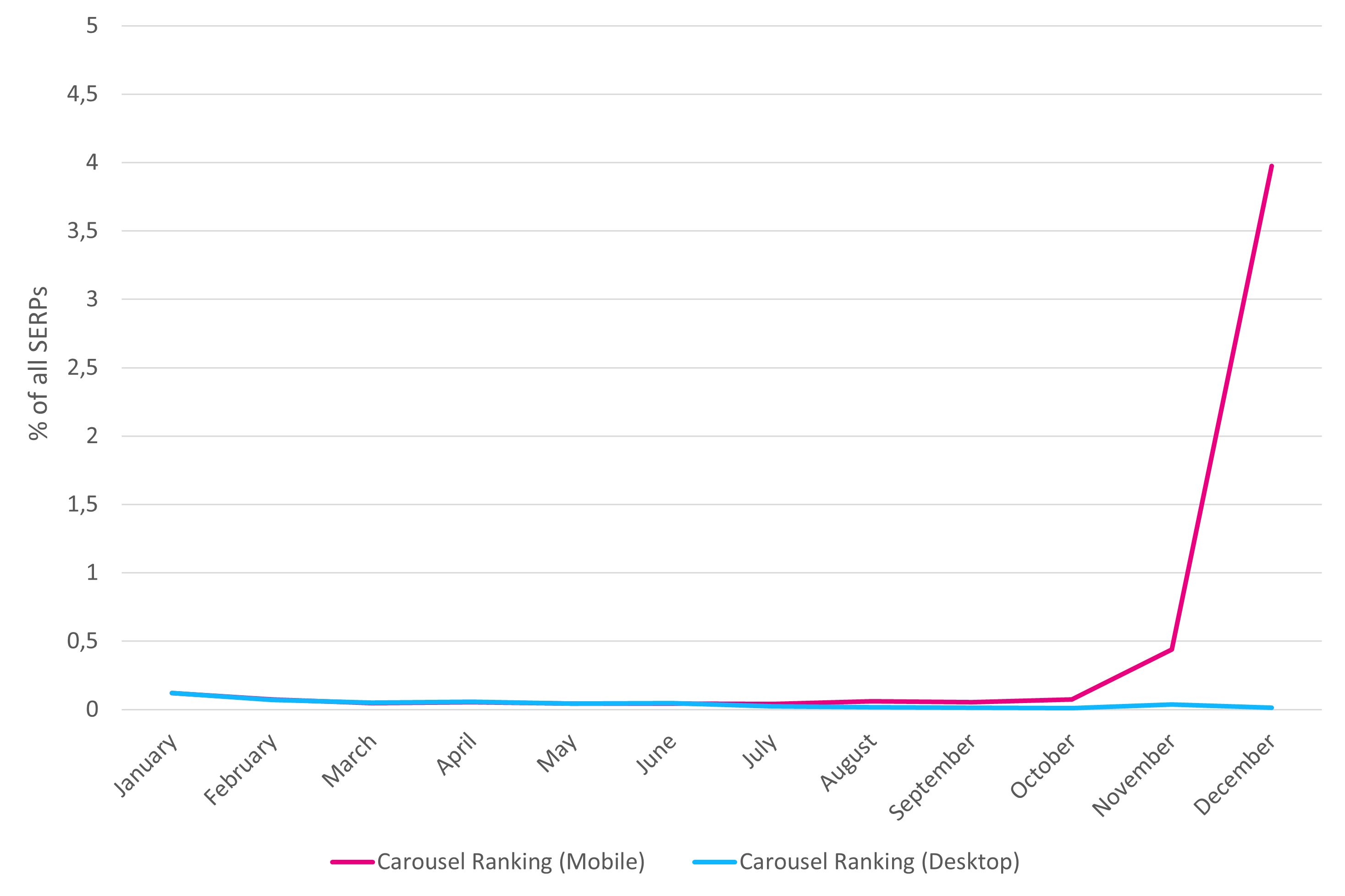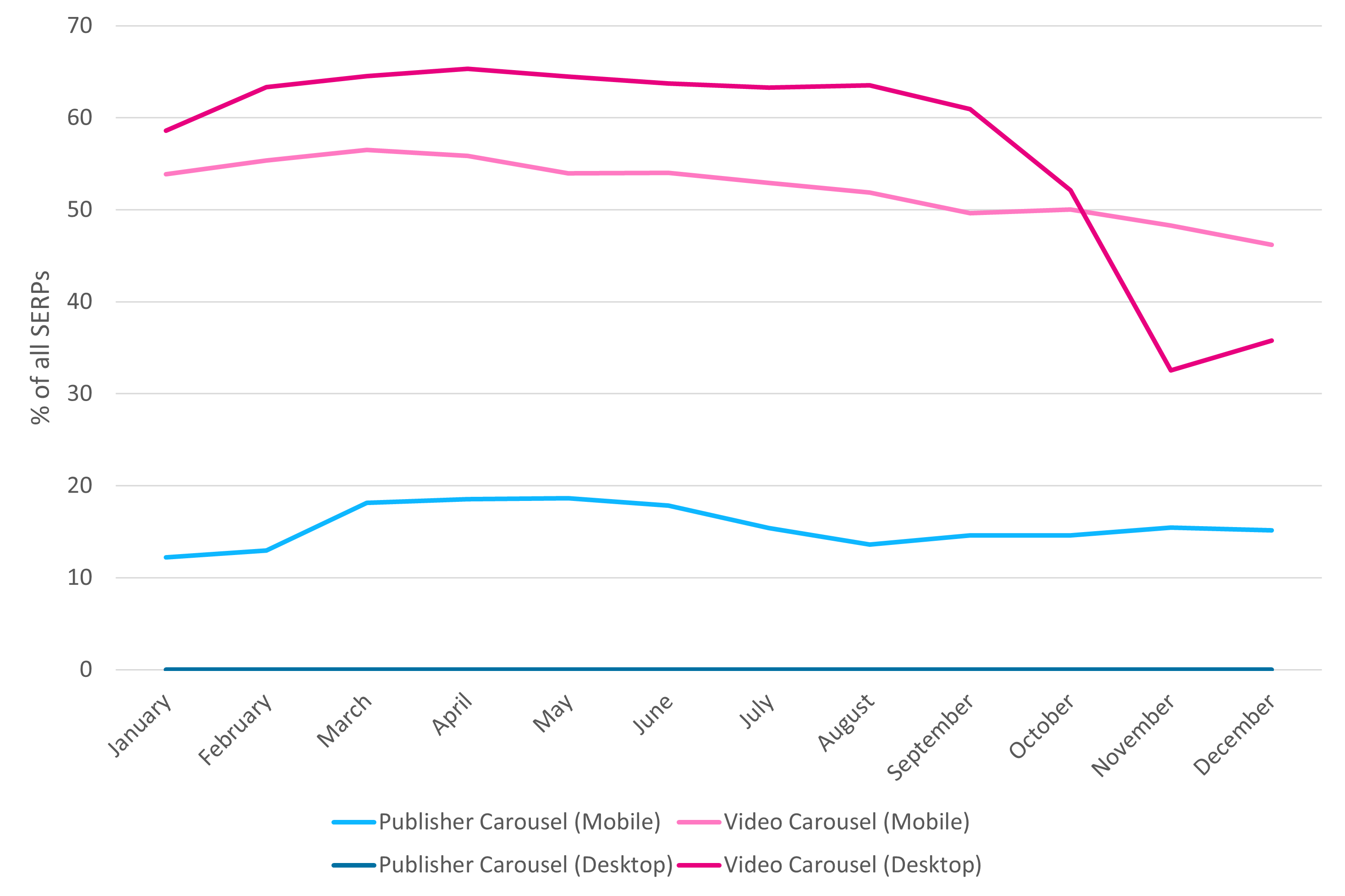Which Ranking Types Play Key Roles on News-Related SERPs?
8. May 2023For news publishers, Google’s search results pages (SERPs) are a significant source of traffic. The SERPs offer various ranking areas, we call them ranking types, to filter search results. There are many different news-related ranking types, such as the News Box, which we do not refer closely to in this blog post. We’re looking at all the other ranking types here, such as organic Rankings, Carousel Rankings, Image Rankings, Featured Snippets, Publisher Carousel, Video Carousel, and Visual Story Rankings. Specifically, we look at how many mobile as well as desktop SERPs had each ranking type in 2022.
Data
In total we found over 100 million SERPs (102,078,377 SERPs). Broken down by Desktop and mobile SERPs, we have found over 50 million on Desktop (50,972,016) and over 51 million mobile SERPs (51,106,361).
News Box on the SERPs
A News Box is probably the most interesting ranking type on the news related SERP for news publishers. We’ll see that in more detail in a moment in the data and is designed to highlight an article with an image and headline. In addition, the publisher’s logo also appears in the ranking.
Findings from 2022 for News Boxes:
We found over 81 million News Boxes (81,271,853) on the SERPs for 2022. In percent, on 78.2 percent of all news-related Desktop SERPs we found a News Box. January was the month with the most News Boxes: 3,512,449 on Desktop SERPs and 3,446,186 on mobile SERPs. Although 2022 started out very strong on the Desktop SERP, the share of News Boxes dropped to 70,9 percent at 4,2 million Desktop SERPs in November.
There were 51,106,361 mobile SERPs in 2022 and we found a News Box on 81.1 percent of all of them. On the mobile SERP, January 2022 was also the month with the most news boxes: there were News Boxes on 84.1 percent of 4,1 million SERPs. After that, the share dropped to the lowest in August: 79.4 percent.
Organic Rankings on SERPs
Starting with the organic rankings. An organic ranking consists of the name of the source, the URL, headline, and meta description, which is a teaser or summary of the content.
On average, there was at least one organic ranking on every SERP, as there was at least one organic ranking on 100 percent of the desktop and also the mobile SERP. Only in January, February, March and July there was “only” 99.9 percent on the mobile SERPs and in January on the desktop SERP.
Carousel Rankings, Publisher Carousels and Video Carousels
Next, we turn our attention to carousel rankings. In the past it used to look like an actual carousel which you can shift to the left. But then Google shifted towards the new style and now puts everything among themselves and we still call it video carousel. A carousel ranking displays several articles on one topic. We distinguish the carousel ranking from the publisher carousel and the video carousel. While a publisher carousel contains only articles of a publisher, the video carousel has only videos as ranking. Another unique feature of publisher carousels is that publisher carousels only exist on the mobile SERP. News publishers get them when they have built up an authority on a certain topic and have thus shown Google that they have a certain expertise in the field. Therefore, it is worthwhile to build up your own strategy in the long term and thus get publisher carousels.
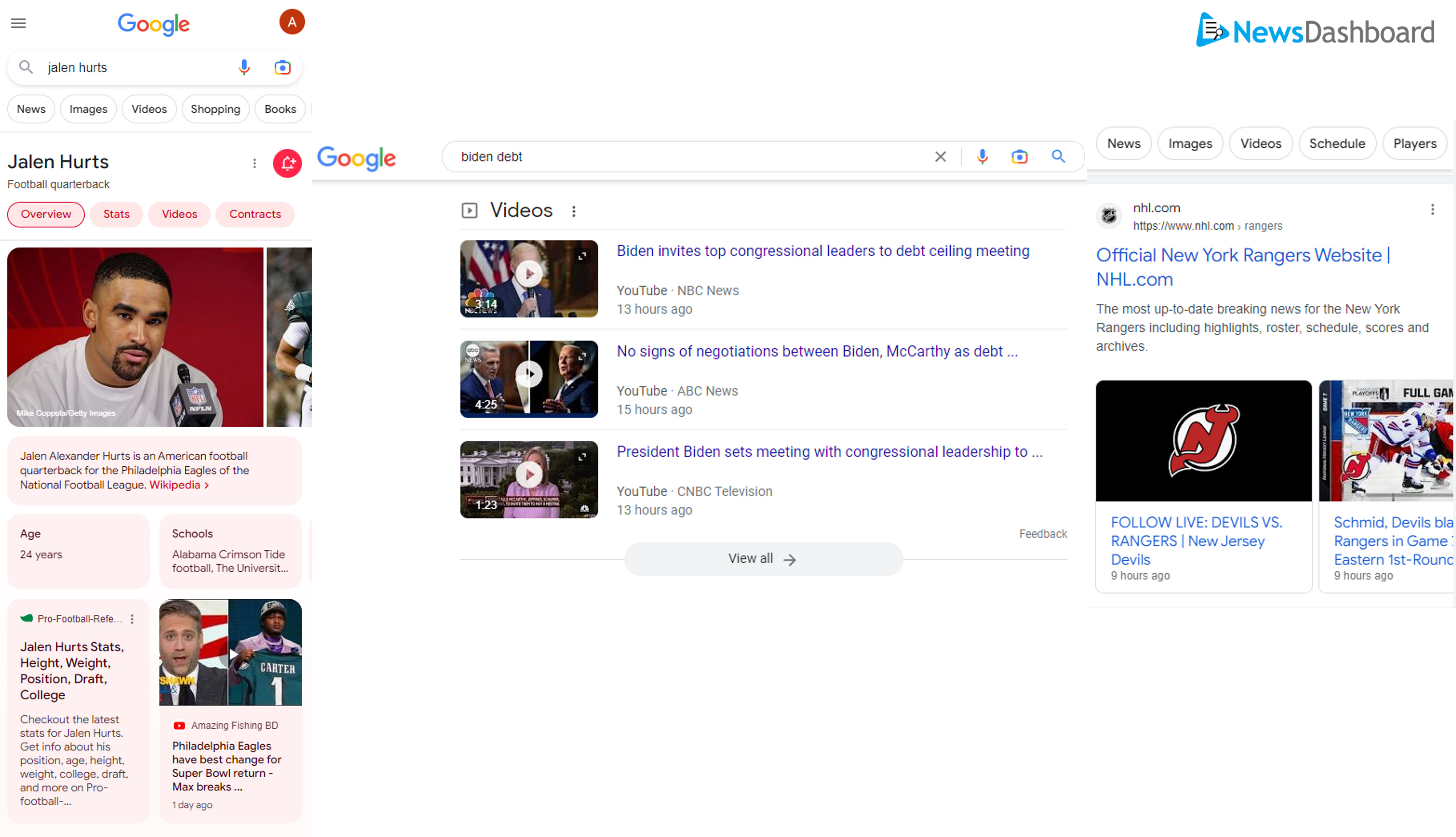
This is how carousel rankings (left), video carousel rankings (middle) and publisher carousel rankings are displayed out on the SERP.
Starting with the carousel ranking: On average, there were 0.04 percent of all desktop SERPs and 0.39 percent of all mobile SERPs. The share of desktop SERPs was 0.12 percent in January and then fell further and further towards 0 percent over the year. On the mobile SERP, the picture is similar, as the share was also 0.12 percent in January, dropped towards 0.04 over the year, but rose to a high of 0.44 percent in December.
The publisher carousel only exists on the mobile SERP. Therefore, the share of desktop SERPs is of course 0 percent. But on the mobile SERP, it shows that while the average is 15.7 percent, the share started at 12.2 percent in January and ranged from 18.15 to 18.66 percent in March to May and then decreased again.
Video carousel rankings are the most appearing of the carousels. On the desktop SERP, there was a video carousel on 57.6 percent on average. However, the peak was 65.3 percent in April and then dropped down to 32.5 percent in November. On the mobile SERP, it was a similar story: On average, there was a video carousel on 52.4 percent of mobile SERPs. In March, the peak was 56.5 percent, but again dropped to 46.2 percent in December. Apparently Google still finds articles with video exciting, but is now giving other ranking types a chance on the SERP. However, YouTube videos often appear as video rankings outside the news box. Thus, the field is particularly competitive here.
Image Rankings, Featured Snippets and Visual Story Rankings
Next, we will look at Image Rankings, Knowledge Rankings and Visual Story Rankings. An Image Ranking consists only of an image that has the article behind it. Featured snippets are special boxes in which the format of a regular search result is reversed and the descriptive snippet is displayed first. They can also appear within a group of related questions, also known as “People Also Ask”, but we don’t look at that data. A Visual Story ranking is also called Web Stories and is a web-based version of the popular Story format, similar to Instagram Stories, allowing creators to host and own their content. In the Visual Story Rankings, an article with several story slides is run through for a certain time, as on Instagram, by displaying an image with text and link if necessary. Alternatively, as with Instagram, the slide can be clicked on.
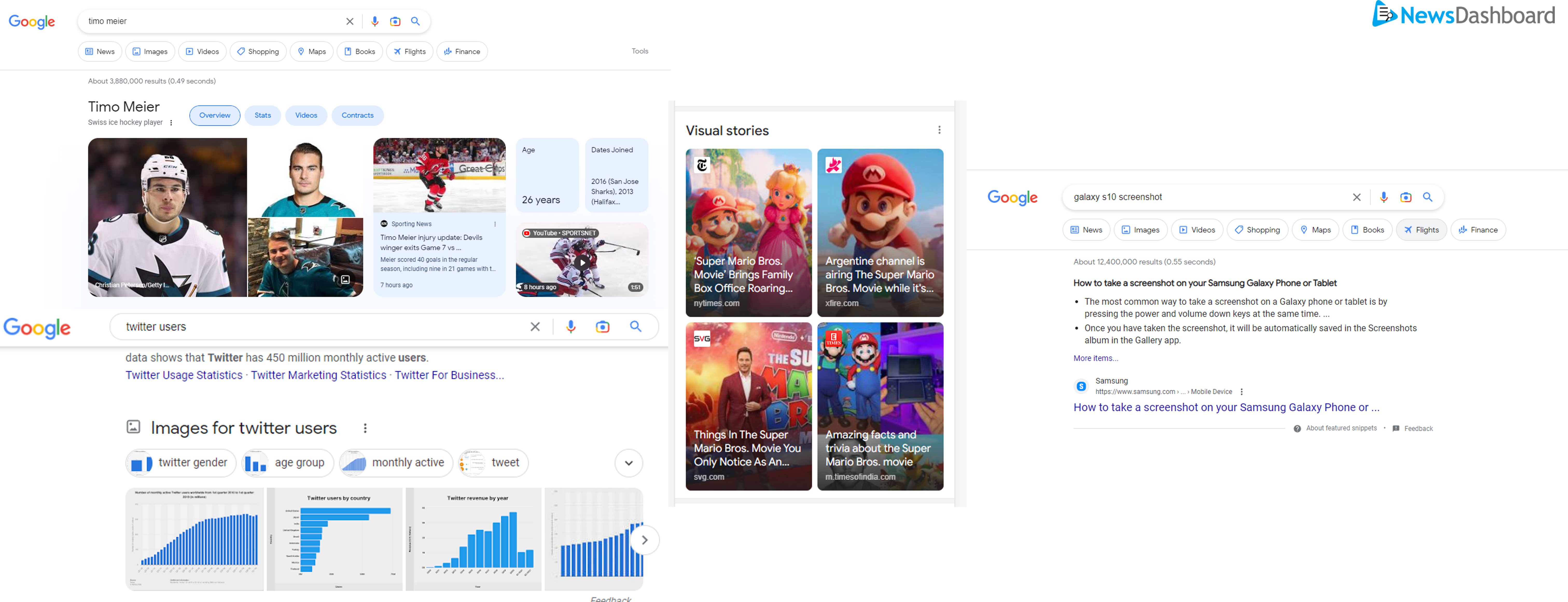
This is how Image Rankings (left), Visual Story Rankings (middle) and Featured Snippet Rankings (right) look on the SERP.
Image rankings were present on 32.5 percent of desktop SERPs on average. In January, the minimum was 26.8 percent and in April the maximum was 35.1 percent. In relation to the mobile SERP, there were significantly more SERPs with image ranking there. On average, 57.8 percent of the mobile SERPs had at least one image ranking. Whereas here in December the minimum was at 51.8 percent of the mobile SERPs and in February the maximum at 62.6 percent. Since this ranking type can also be used to take up space on the search results pages, it is advisable for news publishers to also optimize the images with alt tags, captions and file names, for example.
There are comparatively few SERPs with featured snippets. On average, there was a featured snippet on 8.4 percent of the desktop SERPs and on 9.5 percent of the mobile SERPs. The share on the desktop SERP rose to 9.4 percent in April and May and on the mobile SERP even to over 10 percent in February, April and May. News publishers may achieve this ranking type if they optimize their content, tags and metadata.
SERPs contain visual story rankings even more rarely. This is even less likely on the desktop SERP than on the mobile SERP. Our data shows us that on average 0.4 percent of the desktop SERPs contain a visual story ranking. In relation to the mobile SERP, there was a visual story ranking on 2.7 percent on average. Whereby this ranking type also only appeared on the SERPs from April 2022. There it took about 1 percent on the desktop SERP in April and May. Then the share of SERPs with Visual Story rankings dropped further and further, to 0.2 percent by August. On mobile SERPs, Visual Story rankings seem to be more prevalent. Here, in April, the first month of the ranking type, there were 3.3 percent mobile SERPs with Visual Story rankings. This increased to over 4 percent in May, June and July. After that, the percentage dropped again and in December, there was only a Visual Story ranking on 2.1 percent of mobile SERPs. Nevertheless, this can also change again, since Google always adjusts the SERPs.
Conclusion
Looking at the data from 2022, our findings are:
☞ Carousel rankings make up a very small percentage.
☞ Publisher carousel rankings only exist on the mobile SERP. It is best for news publishers to plan their strategy for the long term and build up expertise and thus authority on a topic.
☞ Video carousel rankings are represented a lot, but often media libraries or YouTube video rankings are in there.
☞ Image rankings offer great potential, as many SERPs have at least one image ranking, with even more common on mobile SERPs. Therefore, news publishers should always optimize images.
☞ Featured snippets also take up a lot of space on the SERP, but are played out on fewer SERPs. Therefore, optimization here can be worthwhile for news publishers.
☞ Visual Story Rankings are reminiscent of Instagram Stories and offer a lot of interaction for the user. However, they are only displayed on relatively few SERPs and if so, then on mobile.
Did you find this News Dashboard analysis helpful? Follow the entire series: 8 Insights into News SEO Every Publisher Needs to Know
You’re not yet part of the News Dashboard family? Request your FREE demo today and find out in which ranking type you rank the most!

